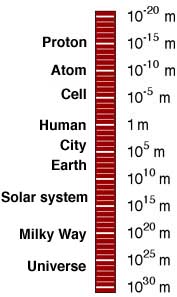Length
 Let's
start our considerations of the base units with an overview of length
scales. For this, we have to resort to logarithmic scales and to
working with powers of 10. The drawing here is in such a logarithmic
scale. This means that equal distances in the drawing mean identical
factors. Here the distance between each two horizontal lines
represents a factor of ten.
Let's
start our considerations of the base units with an overview of length
scales. For this, we have to resort to logarithmic scales and to
working with powers of 10. The drawing here is in such a logarithmic
scale. This means that equal distances in the drawing mean identical
factors. Here the distance between each two horizontal lines
represents a factor of ten.
- The diameter of a proton inside the nucleus of an atom is
about 10-15 m.
- The diameter of an atom is a factor of 100000 (=
105) times bigger than that of the proton, about
10-10 m. This is the smallest length scale that we can
resolve with our best electron microscopes.
- Typical dimensions of microbes, bacteria, and cells in the
human body are about 1 µm = 10-6 m. We can still
use optical microscopes to study this length scale.
- Another factor of 1 million brings us to the height of the
human body, typically between 1.6 and 2.0 m.
- A typical large city has a diameter of about 10 km, another
factor of 104 bigger than the human body.
- The radius of the Earth is 6400 km, the distance between Earth
and the Moon is approximately 384000 km.
- The distance between our planet and the Sun is 148 million km,
and our solar system has a diameter of about 1013
m.
- A light year is the distance that a light beam can travel in
vacuum in one year. The velocity of light is approximately 300000
km/s. Therefore we get:
1 light year = 9.5$\cdot$ 1015 m
- The nearest star is 4 light years away from our solar
system.
- The Andromeda nebula, the nearest galaxy to our own Milky Way,
is about 2 million light years away.
- The radius of the entire Universe is between 10 and 20 billion
light years, or about 1026 m.
© MultiMedia
Physics, 1999
 Let's
start our considerations of the base units with an overview of length
scales. For this, we have to resort to logarithmic scales and to
working with powers of 10. The drawing here is in such a logarithmic
scale. This means that equal distances in the drawing mean identical
factors. Here the distance between each two horizontal lines
represents a factor of ten.
Let's
start our considerations of the base units with an overview of length
scales. For this, we have to resort to logarithmic scales and to
working with powers of 10. The drawing here is in such a logarithmic
scale. This means that equal distances in the drawing mean identical
factors. Here the distance between each two horizontal lines
represents a factor of ten.